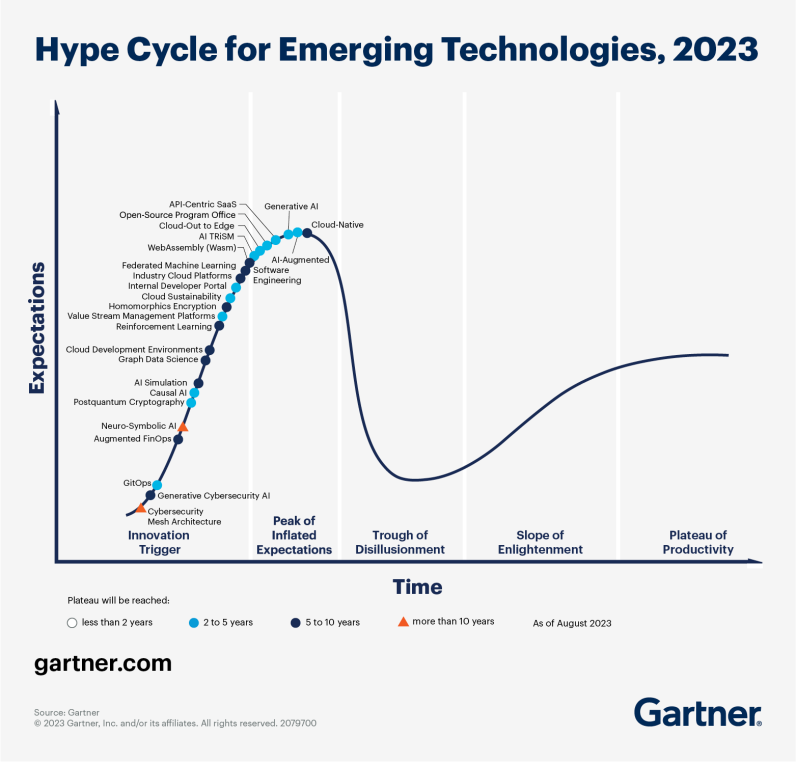Generative AI: Hype, Reality, and the Road Ahead
In 2023, artificial intelligence became mainstream. In 2024, tech insiders anticipate significant shifts in the AI industry.
AI’s much-anticipated reality check arrives in 2024 after a year of unfettered excitement.
🤖 Artificial intelligence went mainstream in 2023. The watershed moment arrived at the end of the previous year, with the November 30 release of ChatGPT. Just two months later, the OpenAI system was reaching an estimated 100 million active users. According to analysts at investment bank UBS, the headline-grabbing chatbot had become the fastest-growing consumer app of all time.
💥 Over the remaining course of 2023, the hype train went into overdrive. Suddenly, AI seemed to be everywhere. It was transforming our lives. It was taking our jobs. It was even threatening to cause an apocalypse. 😱
But let’s not get carried away. The breakthroughs have largely emerged within a single portion of artificial intelligence: generative AI. The excitement sparked by ChatGPT’s text, GitHub Copilot’s code, and Stable Diffusion’s images is yet to spread across the field.
🔍 Is generative AI the be-all and end-all of AI? McKinsey doesn’t think so. According to their report on the state of AI in 2023, “While the use of GenAI might spur the adoption of other AI tools, we see few meaningful increases in organizations’ adoption of these technologies.” In other words, the overall adoption of AI tools hasn’t seen significant growth.
📈 Generative AI still has more to prove. Recent research from Infosys found that only 6% of European companies are producing business value with their GenAI use cases. Gartner’s famous hype cycle for emerging technologies categorizes generative AI at the “peak of inflated expectations.” But brace yourselves, folks, because the next stage for GenAI is the “trough of disillusionment.” Interest will wane, experiments will fail, and producers of the tech will shake out or fail.

🤔 So, what’s next for generative AI? In 2024, expect to see a more cautious and pragmatic approach to AI adoption. “Boardrooms need proof that these investments will increase the bottom line,” says Adi Andrei, director of the UK’s Technosophics and a former senior data scientist at NASA. The industry has poured lots of money and effort into monetizing GenAI solutions like ChatGPT but the results so far are lacking.
⚠️ One critical shortcoming of generative AI is the inaccuracies caused by AI hallucinations. While the text produced by large language models offers a veneer of reason, beneath the surface, these systems merely calculate the probable order of words. Sometimes, these odds don’t lead to correct results. “Such superficial intelligence is not always valuable and reliable, and the industry is waking up to reality,” says Andrei.
Entering New Spaces: Industry Adoption
🏭 Despite the challenges, GenAI is set to enter a growing range of industries in 2024.
According to McKinsey’s research, businesses that rely on knowledge work have the most to gain. The consulting firm expects tech companies to reap the biggest benefits, adding up to 9% of global industry revenue. Other sectors set to cash in are banking (up to 5%), pharmaceuticals and medical products (up to 5%), and education (up to 4%).
Q: Which industries are expected to benefit the most from generative AI?
A: Tech companies, banking, pharmaceuticals, medical products, and education are among the sectors expected to cash in on the benefits of generative AI.

💡 According to Ali Chaudhry, founder of the Generative AI and RL Community in London, GenAI will also spread into manufacturing, engineering, automotive, aerospace, and energy industries. Unfortunately, due to the ongoing global political situation, we might witness growing investments in AI applications in the defense sector as well.
⏳ However, in many sectors, the adoption of AI will be gradual. For example, monetizing AI remains challenging for most players in the games industry. Paraag Amin, CFO of Slovakian startup SuperScale, doesn’t anticipate real revenues to emerge before 2025. Adopting AI into widespread processes takes time, and in this integration phase, monetization models will continue to evolve.
Future Fears: Deepfakes and Web Data Scrapping
😨 There are growing concerns about AI’s inroads into nefarious applications. With 1.5 billion people set to vote in national ballots next year, experts fear that deepfakes will turbocharge political disinformation. Synthetic media also has the power to wreak havoc in boardrooms.
Q: What are the potential risks of AI in the upcoming years?
A: Political disinformation through deepfakes and misuse of synthetic media are among the potential risks associated with AI in the upcoming years.
“Without sophisticated monitoring and detection tools, it’s almost impossible to detect this type of synthetic imagery,” warns Andrew Newell, the chief scientific officer at biometrics firm iProov. “As such, we fully expect to see an AI-generated Zoom call lead to the first billion-dollar CEO fraud in 2024.”
🛂 Another pressing issue for 2024 is the scraping of web data to train AI systems. Critics are now calling for curbs on the practice. Juras Juršėnas, the chief operating officer at web intelligence platform Oxylabs, warns that reining in data scraping will have mixed results. While it may delay innovations in the AI field, it can also bring clarity to data ownership, privacy, and aggregation.
Q: How will data scraping regulations impact the AI field?
A: Restricting data scraping may delay AI innovations, but it can also provide clarity on data ownership, privacy, and aggregation.
Further legal clarity could emerge from regulations. Governments around the world are taking different paths to control AI. The EU’s AI Act applies a sweeping set of rules, while the US follows a more sector-specific model to reduce red tape. In the UK, interventions have fallen somewhere between the two.
📚 Reference Links:
- TomTom and Microsoft Launching AI Driving Assistant
- Apple Reportedly Faces Pressure in India
- Sorry, AI – Humans Invented Things
- The Ukrainian AI Firm Behind Luke Skywalker’s De-Aged Voice
The Tip of the AI Iceberg
🌟 Amid the increasing restrictions and fading hype, analysts expect GenAI to leave a positive legacy for the broader realm of artificial intelligence.
The experiences and technological advances will provide valuable insights, investments, and IT stacks for the sector. In 2024, other emerging techniques could take advantage of the GenAI boom.
🔬 Juršėnas highlights two particularly promising contenders. The first is federated learning, which enables the training of ML algorithms without direct access to private data. This approach enhances efficiencies, performance, algorithms, and privacy.
The second is causal AI, which reduces bias and increases accuracy by equating correlation with causation. Causal AI brings AI closer to the workings of the human mind, posing “what if” questions and probing connections between cause and effect.
Q: What are some emerging AI techniques that can complement generative AI?
A: Federated learning and causal AI are two promising techniques that can enhance the AI field.
As for GenAI, its deployments will depend on the ability of providers to serve models as web-based APIs. While this may not spark a revolution, the results could still be powerful.
The progress from hype to reality is where the true impact emerges. Bownes is bullish about the possibilities. “As the market watchers find something else to look at, real use cases will emerge, the tech will develop, and excitement will begin anew. Much like the aftermath of an eruption, yes, the volcano is exciting, but it’s the fertile land that’s of actual use.”
🔥 So buckle up, ladies and gentlemen, as we navigate through the hype, the disillusionment, and the gradual growth of AI. Generative AI may be the tip of the iceberg, but what lies beneath is a vast and fertile land of possibilities.
What are your thoughts on generative AI’s journey so far? Do you think it will live up to the hype? Share your opinions in the comments below and let’s discuss!
Like this article? Share it on social media and let your friends join the conversation!





